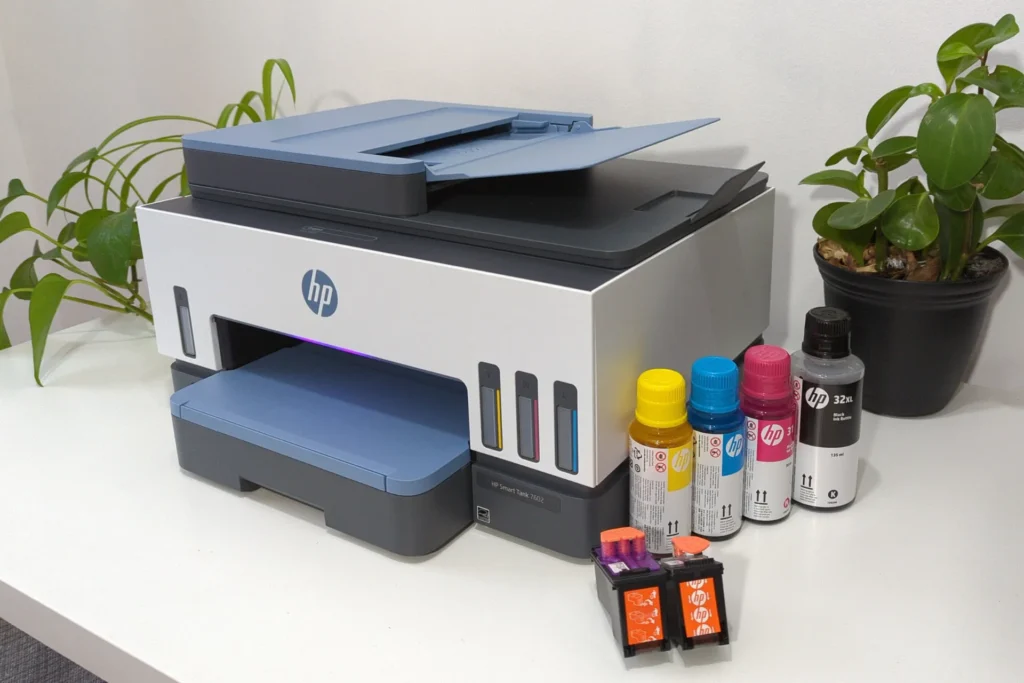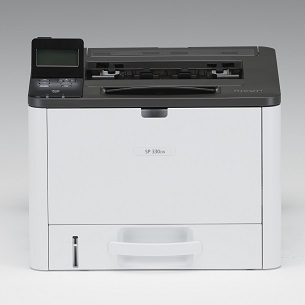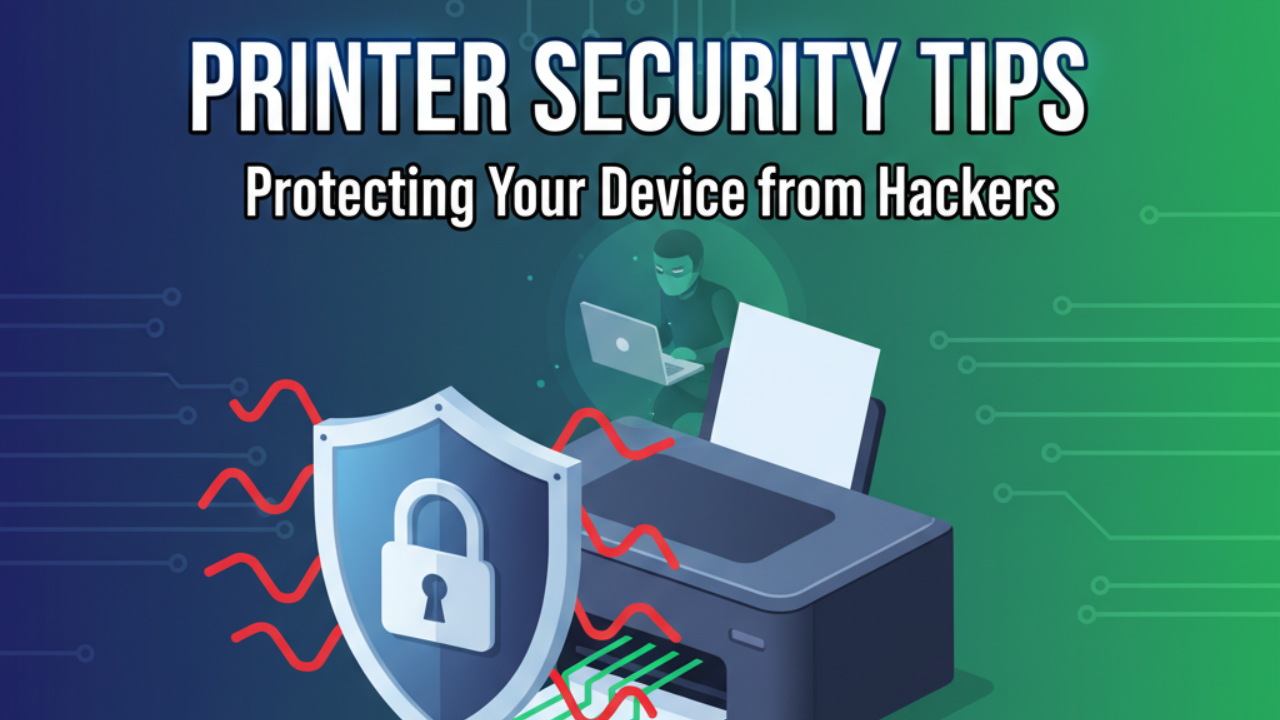Introduction
Printer security tips aren’t exactly dinner table conversation, but they should be. Your printer is basically a computer connected to your network. And just like your laptop or phone, hackers can exploit it.
Most people never think about printer security until it’s too late. They set up their wireless printer, start printing, and forget about it. Meanwhile, that innocent-looking device becomes a backdoor into your entire network.
Here’s the scary part: printer attacks are rising fast. Hackers love printers because they’re often ignored in security planning. No antivirus. No updates. No monitoring. It’s an open invitation.
But don’t panic. Securing your printer isn’t rocket science. In this guide, I’ll share practical printer security tips that actually work. You’ll learn how to protect your device from hackers, spot security threats, and keep your data safe. Let’s dive in.
What Is Printer Security and Why Does It Matter?
Printer security means protecting your printing devices from unauthorized access, data theft, and cyber attacks. It covers everything from network settings to firmware updates to physical access controls.
Think your printer can’t be hacked? Think again. Modern printers store documents in memory. They connect to WiFi networks. Many have hard drives that cache print jobs. Some even have email capabilities and internet access.
Hackers exploit these features. They can intercept print jobs containing sensitive information. They can use your printer to access other devices on your network. They can even turn your printer into a spam-sending bot or use it for cryptocurrency mining.
The consequences get serious fast. Stolen financial documents. Compromised customer data. Leaked business plans. Legal liability. Damaged reputation. One unsecured printer can expose your entire organization.
Small businesses and home offices are especially vulnerable. Large companies have IT departments watching for threats. Individual users? They’re on their own. That’s why understanding printer security tips matters more than ever.
10 Essential Printer Security Tips to Protect from Hackers

1. Change Default Passwords Immediately
This is the most important of all printer security tips. Default passwords are public knowledge. Hackers have databases of every default login for every printer model.
First thing after setup: change the admin password. Make it strong. Use at least 12 characters. Mix letters, numbers, and symbols. Don’t use “password123” or your company name.
Most printers let you access settings through a web interface. Type your printer’s IP address into a browser. Log in with the default credentials (usually “admin/admin”). Then immediately change them.
Don’t write the new password on a sticky note attached to the printer. Use a password manager instead. LastPass, 1Password, or Bitwarden all work great.
2. Update Printer Firmware Regularly
Firmware is basically your printer’s operating system. Manufacturers release updates to fix security holes. Ignoring these updates leaves your printer vulnerable.
Check for firmware updates monthly. Most modern printers have an auto-update feature. Enable it. This ensures you get security patches as soon as they’re available.
To manually check, visit your printer manufacturer’s support website. Enter your model number. Download the latest firmware. Follow the installation instructions carefully.
Never interrupt a firmware update. Power loss during installation can brick your printer. Keep it plugged in and connected until the update finishes completely.
3. Disable Unnecessary Network Protocols
Printers support tons of network protocols. You probably need three or four. The rest just create security risks.
Log into your printer’s admin panel. Find the network settings. Disable protocols you don’t use. Common culprits include Telnet, FTP, SNMP v1/v2, and legacy print protocols.
Keep HTTPS enabled for encrypted web access. Keep IPP (Internet Printing Protocol) if you print from mobile devices. Disable everything else unless you specifically need it.
This reduces your attack surface. Fewer open doors mean fewer opportunities for hackers to break in.
4. Use Network Segmentation
Don’t let your printer access everything on your network. Create a separate network segment for printing devices.
Most routers support VLANs (Virtual Local Area Networks). Set up a dedicated VLAN for printers. This isolates them from computers, servers, and other critical devices.
If your router doesn’t support VLANs, use a guest network. Connect your printer to the guest WiFi. This creates natural separation from your main network.
Segmentation limits damage if your printer gets compromised. Hackers gain access to the printer network only, not your entire system.
5. Enable Encryption for All Print Jobs
Unencrypted print jobs are like postcards. Anyone on the network can read them. These printer security tips include always using encryption.
Enable SSL/TLS encryption in your printer settings. This scrambles data as it travels from computer to printer. Even if intercepted, the data looks like gibberish.
For WiFi printers, use WPA3 encryption on your router. If WPA3 isn’t available, use WPA2. Never use WEP encryption. It’s easily cracked.
Some business printers support print job encryption with PIN codes. Users must enter a code at the printer to release their documents. This adds another security layer.
6. Implement User Authentication
Public printers are security nightmares. Anyone can walk up and print anything. Or worse, anyone can grab someone else’s printed documents.
Set up user authentication. Require people to log in before printing. Most network printers support this through Active Directory, LDAP, or local user accounts.
Use pull-printing or secure-release printing. Documents sit in a queue until the user authenticates at the printer. This prevents sensitive documents from sitting in output trays.
Track who prints what. Enable print logging. This creates accountability and helps identify suspicious activity.
7. Secure Physical Access to Printers

Physical security matters too. Someone with physical access can bypass most digital protections.
Place printers in secure areas. Not in reception areas where visitors roam freely. Not in hallways where anyone can access them.
Use the printer’s physical lock port if available. Some models let you lock down the control panel. This prevents unauthorized configuration changes.
Secure or remove hard drives from decommissioned printers. Old printer hard drives contain cached documents. Wipe them completely or destroy them physically before disposal.
8. Disable Remote Printing Features When Not Needed
Cloud printing and remote access are convenient. They’re also potential security holes. Apple AirPrint, Google Cloud Print, email-to-print features all create additional attack vectors.
Disable remote printing features unless you actively use them. Most people set up these features and forget about them.
If you need remote printing, use a VPN. Don’t expose your printer directly to the internet. Route remote access through your company’s VPN for encrypted, authenticated connections.
Check which services are running in your printer’s web interface. Turn off anything you don’t recognize or use.
9. Monitor Printer Activity and Logs
You can’t protect what you don’t monitor. Regular monitoring helps catch security issues early.
Enable logging on your printer. Most models log access attempts, configuration changes, and print jobs. Review these logs weekly.
Look for suspicious patterns. Failed login attempts. Odd print jobs. Configuration changes you didn’t authorize. Access from unknown IP addresses.
Set up alerts if your printer supports them. Get notifications for specific events like failed logins or firmware changes. This provides real-time security awareness.
10. Create a Printer Security Policy
Ad-hoc security doesn’t work. You need a formal policy. Even for home offices, basic guidelines help.
Document your printer security practices. Who can access the printer? How often do you update firmware? What’s the password policy? When do you review logs?
For businesses, make printer security part of employee onboarding. Teach staff why these printer security tips matter. Show them how to print securely.
Review and update your policy annually. Technology changes. Threats evolve. Your security practices should too.
Additional Tools for Printer Security

Security Scanning Software
Specialized tools can audit your printer security. HP JetAdvantage Security Manager, PrinterLogic, and PaperCut all offer security features.
These tools scan for vulnerabilities. They check firmware versions, weak passwords, and risky configurations. Many provide automated remediation too.
For home users, general network scanners like Nmap or Angry IP Scanner can identify printers and check for open ports.
Firewall Configuration
Your firewall is crucial for printer security. Configure it to restrict printer network access.
Create rules that limit which devices can communicate with your printer. Block inbound connections from the internet. Allow only necessary outbound connections.
Many routers have basic firewall features. Use them. More advanced users might consider dedicated firewall hardware or software.
Print Management Software
Print management platforms add security layers. They control who prints what, track usage, and enforce policies.
Popular options include PaperCut, PrinterLogic, and Equitrac. These work especially well in business environments with multiple users and printers.
Some offer features like secure pull-printing, cost tracking, and detailed audit trails. Worth the investment if you handle sensitive documents regularly.
Common Mistakes in Printer Security
Assuming Printers Don’t Need Security
The biggest mistake? Thinking printers aren’t worth securing. They’re just printers, right? Wrong. This mindset creates massive vulnerabilities.
Printers are computers. They run operating systems. They connect to networks. They store data. Hackers know this even if users don’t.
Treat your printer with the same security consciousness as your laptop. Apply the same printer security tips you’d use for any networked device.
Using Outdated Printer Models
Old printers often lack security features. No encryption support. No secure protocols. No firmware updates. They’re essentially unsecurable.
If your printer is more than 7-10 years old, consider replacing it. Modern printers have built-in security features that older models simply can’t match.
The cost of a new printer is far less than the cost of a data breach. Do the math.
Ignoring Mobile Printing Security
Mobile printing is convenient but risky. Apps like AirPrint and Mopria Connect often bypass normal security controls.
Don’t leave mobile printing wide open. Configure it properly. Use authentication when possible. Restrict which devices can print.
Many WiFi printers allow direct peer-to-peer connections from phones. This bypasses your router’s security entirely. Disable this feature unless absolutely necessary.
Forgetting About Printer Disposal
Throwing away or selling an old printer without wiping its memory is a critical mistake. Printer hard drives and memory can contain years of cached documents.
Before disposing of any printer, perform a factory reset. Better yet, physically remove and destroy the hard drive if it has one.
Check your printer manual for proper data deletion procedures. Some manufacturers provide specialized tools for secure data wiping.
Not Testing Security Measures
Implementing printer security tips without testing them is pointless. You need to verify your protections actually work.
Try to access your printer from unauthorized devices. Attempt to intercept print jobs. Test your authentication systems. See if you can access the admin panel without proper credentials.
Regular security testing reveals gaps before hackers do. Schedule quarterly security audits for your printing infrastructure.
Troubleshooting Printer Security Issues
Printer Keeps Getting Unauthorized Access
First, change all passwords immediately. Check for unauthorized users in the printer’s access logs. Review firewall rules to ensure only authorized devices can connect.
Update firmware to the latest version. Check if any remote access features are enabled and disable them if not needed. Consider moving the printer to a more secure network segment.
Print Jobs Being Intercepted
Enable SSL/TLS encryption for all print traffic. Verify your WiFi uses WPA3 or at least WPA2 encryption. Check for unauthorized devices on your network using network scanning tools.
Implement secure pull-printing so documents don’t print until the user authenticates at the printer. This prevents interception and physical document theft.
Printer Sending Spam or Strange Network Traffic
Your printer may be compromised. Disconnect it from the network immediately. Perform a factory reset. Update to the latest firmware version.
Scan your entire network for malware. The printer infection might have spread. Change all network passwords after cleaning the system.
Cannot Access Printer After Security Updates
Sometimes security measures break functionality. If you can’t access your printer after implementing these tips, work backward systematically.
Check if you’re using the correct credentials. Verify the printer’s IP address hasn’t changed. Ensure your device is on the correct network segment if you implemented segmentation.
Review firewall logs to see if connections are being blocked. Temporarily disable new rules one at a time to identify the problem.
Frequently Asked Questions
Q: How often should I update my printer firmware?
Check for firmware updates monthly. Enable automatic updates if your printer supports this feature. Manufacturers release security patches regularly, and outdated firmware is a major vulnerability. Set a calendar reminder to check the manufacturer’s support website if automatic updates aren’t available.
Q: Can hackers really access my home printer?
Absolutely. If your printer connects to the internet or your home network, it’s potentially accessible to hackers. They can exploit weak passwords, outdated firmware, or misconfigured security settings. Following these printer security tips significantly reduces this risk, but no internet-connected device is 100% safe.
Q: What’s the biggest printer security threat?
Default passwords represent the biggest threat. Hackers use automated tools that try default credentials on thousands of printers simultaneously. Changing default passwords immediately after setup is the single most effective printer security tip you can implement.
Q: Do I need antivirus software for my printer?
Most printers don’t support traditional antivirus software. Instead, focus on firmware updates, strong passwords, network segmentation, and monitoring. Some enterprise-grade printers offer built-in security software, but these are uncommon in consumer models. Following comprehensive printer security tips provides better protection than relying on antivirus alone.
Q: Should I turn off my printer when not using it?
From a security perspective, yes. Powered-off printers can’t be hacked. However, this isn’t always practical. If you can’t power down regularly, ensure you’ve implemented all other printer security tips. Use strong passwords, update firmware regularly, and monitor for suspicious activity.
Conclusion
Printer security tips aren’t optional anymore. They’re essential for protecting your data, your network, and your privacy. Hackers actively target printers because most people ignore them in security planning.
The good news? Securing your printer doesn’t require expert knowledge. Change default passwords. Update firmware regularly. Disable unnecessary features. Use encryption. Monitor activity. These simple steps dramatically improve your security.
Don’t wait for a breach to take action. Implement these printer security tips today. Start with the basics like passwords and firmware updates. Then layer on additional protections like network segmentation and encryption.
Remember that printer security is ongoing. It’s not a one-time setup. Technology evolves. Threats change. Your security practices must adapt too. Review your printer security quarterly at minimum.
Your printer is a gateway to your digital life. Protect it like you’d protect your computer or smartphone. The few minutes you invest in security today could save you from massive headaches tomorrow.
Ready to secure your printer? Bookmark this guide and implement one printer security tip per week. Share this with colleagues and friends who might be vulnerable. Security works best when everyone participates.
External Resource: For the latest printer security advisories and vulnerability reports, visit the US-CERT Cybersecurity Advisories page




